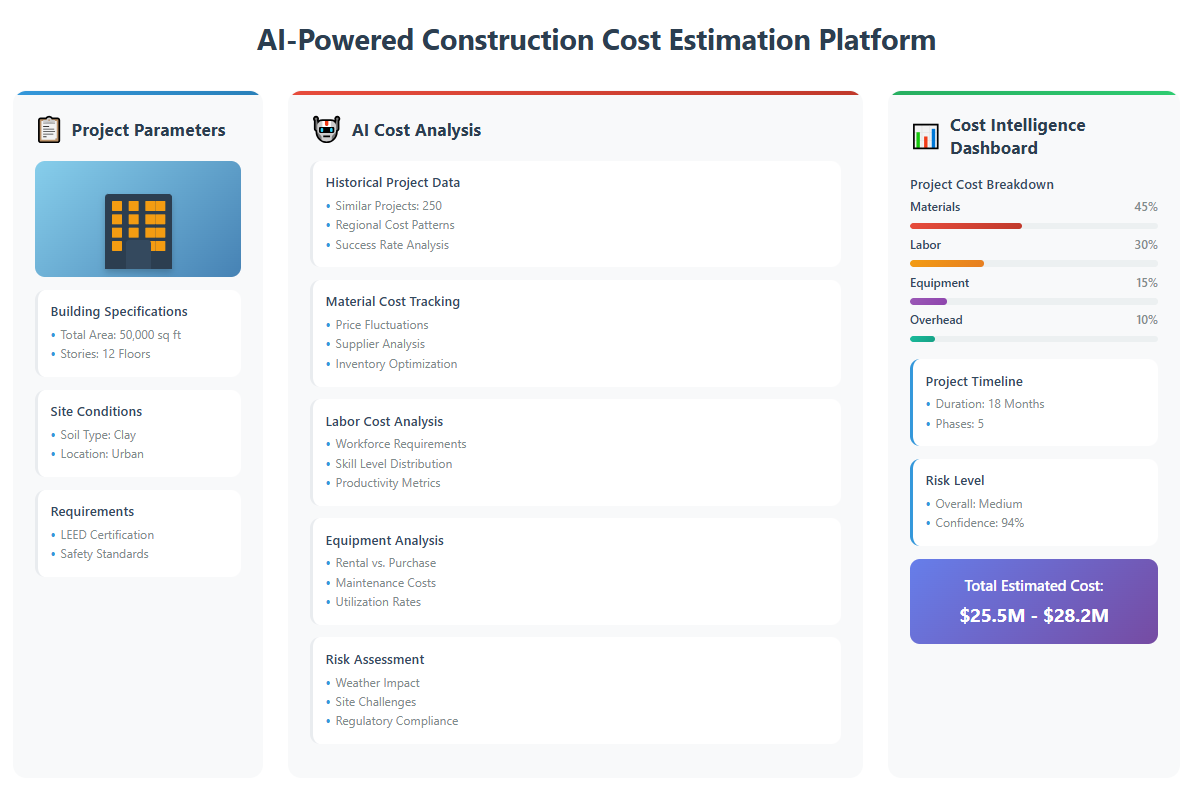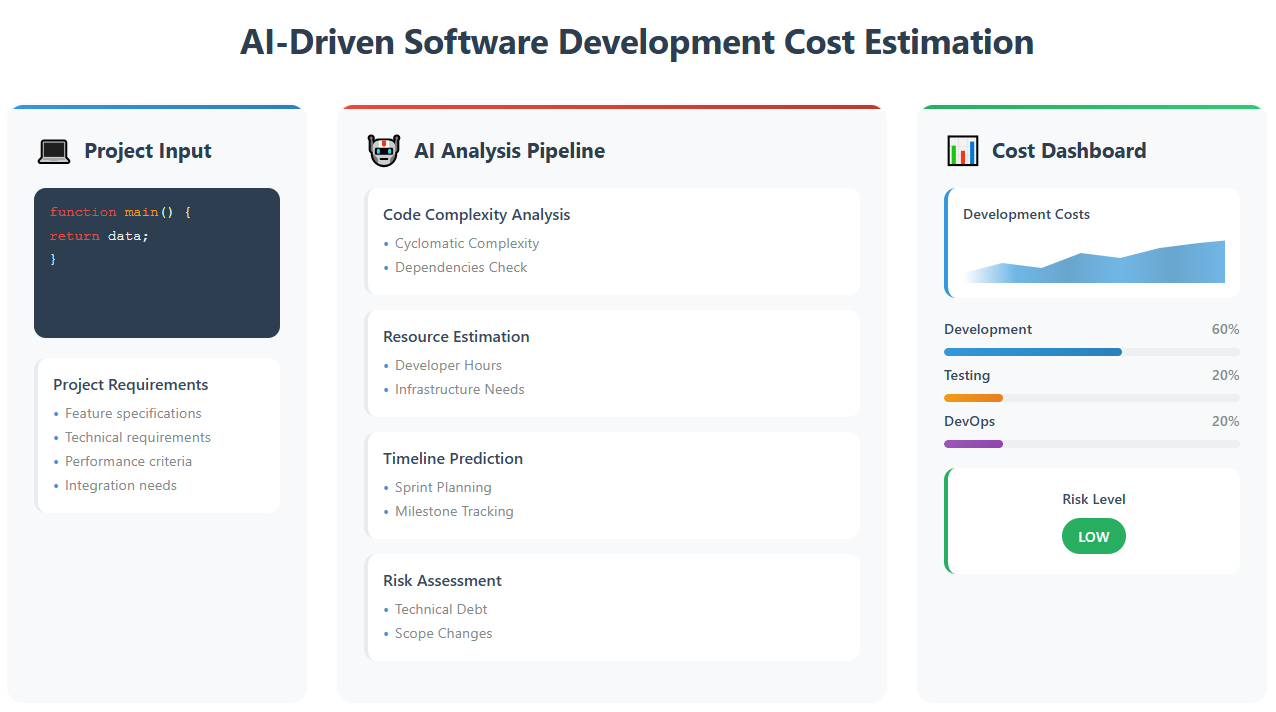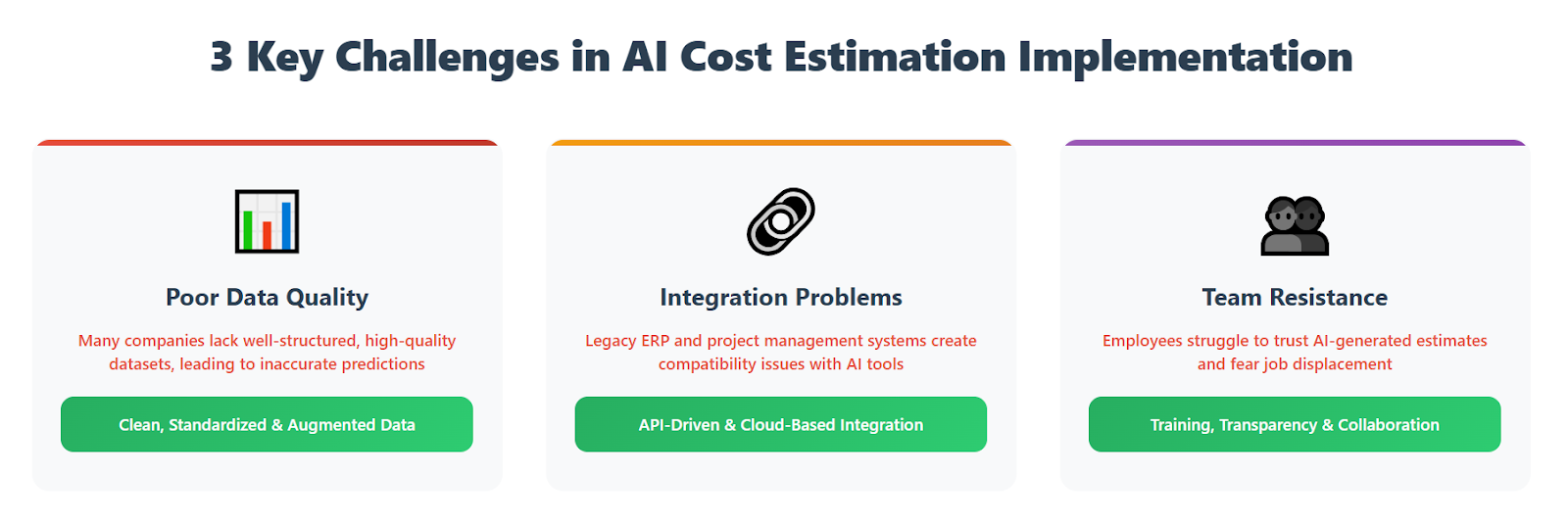McKinsey's analysis of over 500 major projects shows the average project runs 79% over budget. As this pattern destroys countless projects and careers, smart organizations are embracing AI-driven cost estimation.
Recent breakthroughs in artificial intelligence have transformed cost estimation from subjective assumptions into objective, data-backed projections. This fundamentally different approach to project budgeting is finally delivering the accuracy the industry has been missing.
In this article, you will:
- Discover how AI revolutionizes your project budgeting accuracy
- Master AI project cost estimation in your industry
- Select the ideal AI estimation tool for your needs
- Solve common AI estimation challenges with proven strategies
AI project cost estimation: How AI transforms budget forecasting
Traditional cost estimation relies on static spreadsheets and historical averages, methods that consistently fail to capture the dynamic complexity of modern projects.
AI project cost estimation fundamentally changes this approach by processing vast datasets, recognizing hidden patterns, and adapting in real-time as conditions change.
Key Benefits of Artificial Intelligence for Cost Estimation:
- Pattern Recognition: Identifies cost trends across thousands of historical projects that humans miss
- Real-Time Adaptation: Automatically adjusts estimates as market conditions and project variables change
- Risk Prediction: Calculates probability-based contingencies and alerts to potential overruns before they happen
- Integration: Seamlessly connects with existing project management and financial systems
- Continuous Learning: Improves accuracy with each new project added to the database

Harnessing historical data through machine learning
At the heart of AI-powered cost estimation lies its ability to analyze vast amounts of historical data and generate transparent, data-driven insights. Machine learning algorithms can process thousands of past projects in minutes, identifying patterns and relationships that humans might miss. These algorithms:
- Transform raw project data into actionable insights
- Learn from successful and failed project estimates
- Identify hidden cost drivers and correlations
- Adapt to industry-specific cost patterns
- Continuously improve estimation accuracy with each new project
The real power lies in the system's ability to understand the complex relationships between different project variables. For instance, when estimating the cost of a construction project, AI can simultaneously consider factors like material prices, labor costs, seasonal variations, and regional economic indicators.
Smart pattern recognition in project cost analysis
AI systems excel at recognizing patterns in historical project costs, offering insights that revolutionize the estimation process. These patterns become the foundation for more accurate future predictions. The system can:
- Identify cost trends across similar projects
- Detect seasonal cost fluctuations
- Understand the impact of project scale on costs
- Recognize cost anomalies that might indicate risks
- Account for industry-specific cost patterns
For example, an AI system might notice that software development projects starting in Q4 typically experience a 15% cost increase due to holiday season resource constraints - a pattern that might be subtle enough to escape human observation.
Dynamic real-time cost adjustments
One of AI's most powerful features is its ability to make real-time adjustments to cost estimates as project conditions change. This dynamic capability ensures that estimates remain accurate throughout the project lifecycle by:
- Monitoring market conditions and adjusting costs accordingly
- Updating estimates based on actual project progress
- Incorporating new data as it becomes available
- Alerting project managers to potential cost overruns before they occur
- Suggesting cost optimization opportunities in real-time
This real-time adjustment capability means that project managers can make informed decisions quickly, rather than waiting for monthly or quarterly review cycles.
Seamless integration with project management tools
AI cost estimation systems don't exist in isolation. They become even more powerful when integrated with existing project management infrastructure. Modern AI solutions offer:
- Direct connection to project management software
- Automated data synchronization
- Real-time dashboard updates
- Custom reporting capabilities
- Integration with financial systems
This integration creates a seamless workflow where cost estimates are automatically updated as new project data becomes available, ensuring that all stakeholders work with the most current information.
Advanced risk assessment and contingency planning
One of the most valuable aspects of AI in cost estimation is its ability to perform sophisticated risk assessment and contingency calculations. The system can:
- Identify potential risk factors from historical data
- Calculate probability-based contingency reserves
- Model different risk scenarios
- Suggest mitigation strategies based on past successes
- Adjust risk assessments in real-time
For instance, if an AI system identifies that similar projects historically faced a 30% chance of material cost overruns during certain seasons, it can automatically adjust contingency reserves and suggest preventive measures.
How different industries use AI for cost estimation
The power of AI cost estimation isn't just theoretical - it's revolutionizing how businesses across various sectors approach their budgeting and planning processes. Let's explore how different industries are leveraging AI to transform their cost estimation practices.
Construction: Building the future with precision
The construction industry is notorious for budget overruns, often due to unforeseen costs, inaccurate estimates, and fluctuating material prices. AI is transforming this sector by:
- Analyzing thousands of past construction projects to predict cost variations.
- Tracking real-time material price fluctuations and adjusting estimates dynamically.
- Optimizing labor costs based on workforce availability and productivity rates.
- Assessing weather conditions and their impact on project timelines and budgets.
- Reducing manual estimation errors, ensuring more accurate project bids and cost forecasts.

🔹 Industry Impact: The World Economic Forum estimates that AI integration can reduce construction project costs by 20% and project durations by 15%. McKinsey research identified 37 specific use cases for AI technology in construction, spanning from automated scheduling to predictive maintenance of heavy machinery
Tech sector: Revolutionizing software project budgeting
IT projects, especially software development, often face unexpected scope changes, delays, and miscalculated resource costs. AI helps by:
- Predicting development time and costs based on past software projects.
- Automatically adjusting budgets when new features are added or removed.
- Forecasting staffing requirements and preventing over-hiring or under-hiring.
- Reducing financial risks in Agile and DevOps environments by identifying inefficiencies in project workflows.

🔹 Industry Impact: Research conducted by McKinsey and the University of Oxford on over 5,400 IT projects found that traditional methods lead to 45% budget overruns on average. Academic studies show that AI-powered neural networks can analyze complex datasets and produce significantly more accurate cost predictions than conventional estimation methods
Manufacturing: Precision in production costs
Manufacturing companies deal with complex cost structures, including raw materials, labor, logistics, and machine usage. AI is making cost estimation more accurate by:
- Analyzing supplier price trends and predicting future cost fluctuations.
- Optimizing production schedules to reduce idle time and minimize labor costs.
- Simulating different production scenarios to determine the most cost-effective strategies.
- Predicting maintenance costs using AI-driven predictive analytics, preventing costly equipment failures.

🔹 Industry Impact: Fortune 500 companies implementing AI predictive analytics report dramatic reductions in unplanned downtime and associated costs, with some achieving ROI in less than three months. AI-driven maintenance solutions have helped industrial companies slash downtime by up to 50% while reducing maintenance expenses by 40%.
Real estate development: Smart property investment planning
Real estate developers rely heavily on cost estimates to secure funding and plan profitable projects. AI is revolutionizing the industry by:
- Predicting land acquisition costs based on zoning regulations, demand trends, and past sales data.
- Calculating construction costs dynamically, factoring in labor, materials, and permits.
- Assessing market risks by analyzing economic conditions, interest rates, and local real estate trends.
- Optimizing property valuation by comparing similar projects and identifying profitable investment opportunities.

🔹 Industry Impact: Research analyzing machine learning applications in construction shows these techniques consistently outperform traditional parametric estimation methods. Studies indicate that AI systems can process complex market variables and historical project data to generate more reliable cost forecasts than human-only approaches.
Infrastructure projects: Mastering large-scale operations
Infrastructure projects, such as multi-lane highways, steel bridges, and energy plants, involve massive budgets, long timelines, and regulatory challenges. AI is improving cost estimation by:
- Analyzing thousands of past infrastructure projects to generate precise cost predictions.
- Tracking material and labor costs across multiple geographic regions for better budget planning.
- Simulating different project scenarios to identify the most cost-effective solutions.
- Predicting long-term maintenance costs to ensure sustainability and minimize future expenses.

🔹 Industry Impact: McKinsey research shows that 98% of megaprojects suffer cost overruns of more than 30%, with 77% running at least 40% late. AI-powered progress monitoring systems using computer vision can identify project deviations early, allowing managers to respond based on verified data rather than assumptions
AI-powered cost estimation tools: Choose your perfect match
Finding the right AI cost estimation tool can transform your project planning process. Here's a comprehensive comparison of leading solutions across industries:

Making the Right Choice: Key Considerations
When selecting your AI cost estimation tool, focus on these crucial factors:
Implementation Requirements
- Data Readiness: How much historical data do you have?
- Team Expertise: What's your team's technical capability?
- Integration Needs: Which systems need to connect?
Budget Alignment
- Enterprise Solutions: IBM Watson, SAP Leonardo, Cleopatra
- Mid-Market Options: Procore, Azure Cost Estimation
- Cost-Effective Choice: OpenCost (open-source)
The best tool is one that matches your specific needs while providing room for growth. Consider starting with a pilot project to test your chosen solution before full implementation.
Top 3 AI implementation challenges
Implementing AI cost estimation brings powerful benefits, but success requires overcoming key challenges. Here's how to identify and solve common implementation hurdles.

1. Poor data quality & incomplete historical records
The Problem: AI relies on historical data to generate accurate cost estimates. However, many companies lack well-structured, high-quality datasets, leading to inaccurate predictions.
The Solution: Clean, Standardized & Augmented Data
- Conduct a Data Audit - Identify gaps, inconsistencies, and errors in historical cost records.
- Standardize Data Formats - Ensure data is structured, categorized, and labeled correctly.
- Utilize AI-Powered Data Cleaning Tools - Automated data validation tools can improve accuracy and fill missing gaps.
- Incorporate External Data Sources - AI can enhance accuracy by pulling in market trends, inflation rates, and supplier cost fluctuations.
2. Integration problems with existing systems
The Problem: Many companies use legacy ERP, accounting, and project management software. AI cost estimation tools must integrate seamlessly, but incompatibility issues often arise.
The Solution: API-Driven & Cloud-Based Integration
- Choose AI Tools with API Compatibility - Ensure AI software supports API-based integration with existing systems.
- Adopt Cloud-Based AI Solutions - Cloud platforms enable real-time data exchange, reducing manual inputs.
- Create a Data Pipeline Strategy - Work with IT teams to map data flow between systems.
- Test in a Sandbox Environment First - Before full deployment, pilot AI integrations to identify potential issues.
3. Team adoption hurdles & resistance to change
The Problem: Employees fear AI may replace their jobs, while project teams may struggle to trust AI-generated estimates. Resistance can slow down AI adoption and reduce effectiveness.
The Solution: Training, Transparency & Collaboration
- Educate Teams on AI’s Role - AI is not a replacement but an enhancement tool to support human decision-making.
- Provide Hands-On Training - Organize workshops & tutorials on how AI-powered cost estimation works.
- Show Proof of AI’s Accuracy - Conduct side-by-side comparisons of AI-generated estimates vs. traditional methods.
- Create a Gradual Adoption Plan - Start with pilot projects before scaling AI implementation.
Future-proof your budgets with AI-driven estimation
Traditional cost estimation methods struggle to keep up with today’s fast-paced, data-driven industries. AI is changing the game by enhancing accuracy, minimizing risks, and optimizing resource allocation like never before.
The future belongs to AI-assisted cost estimation, which helps businesses eliminate budget overruns and maximize efficiency. Don’t get left behind.
Supercharge your project efficiency with an AI-powered project management tool. Streamline workflows, enhance collaboration, and drive smarter decision-making with Dart.
Frequently asked questions
How can organizations forecast AI implementation costs at scale?
Track current usage metrics and costs per project or task. Analyze historical patterns to identify scaling factors like computational requirements and infrastructure needs. Consider that AI systems typically become more efficient with larger datasets and increased usage volume.
How accurate are AI-driven spending predictions in large-scale projects?
AI systems consistently outperform traditional methods. McKinsey research shows traditional projects run 79% over budget on average, while AI-powered tools demonstrate significant improvements in cost prediction accuracy. Construction and manufacturing sectors show the strongest results due to standardized processes and extensive historical datasets.
How to use AI in construction cost estimation?
Input project specifications, drawings, and requirements into the AI platform. The system processes this data against historical project databases. Review generated estimates and incorporate project-specific factors that the AI may not capture. Integrate with existing project management workflows for ongoing monitoring.
What ROI can organizations realistically expect from AI cost estimation investments?
Organizations see an average 3.5X return on AI investments, with top performers achieving 8X returns. Recent studies show 92% of early adopters report positive ROI, averaging $1.41 return for every dollar invested.
What are the most significant implementation challenges organizations face with AI cost estimation?
85% of leaders identify data quality as their biggest challenge. Other major hurdles include high initial implementation costs, the need for specialized training, and integration with existing systems.


%20(1).jpg)
_light%201.png)





